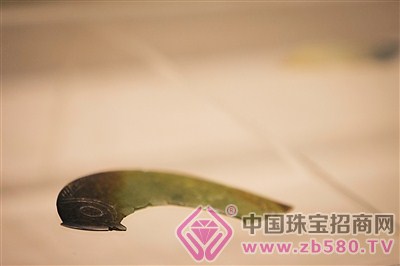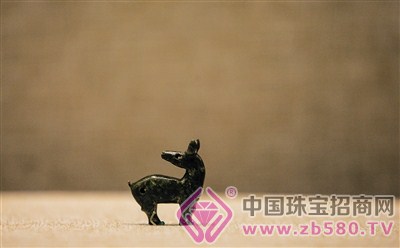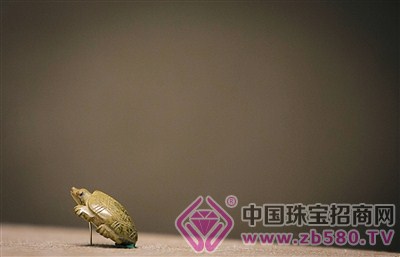
Jade fish

Looking back at Yulu

Jade turtle
The jade wares of China have a long history, and the jade wares of the Western Zhou Dynasty have also been splendid. The jade artifacts unearthed in the formula country reproduce the historical features of the jade articles in the early and middle Western Zhou Dynasty. The “De Jade†culture contained in them is also an important part of the traditional Chinese ritual jade culture. In order to let the people of Hainan share the feast of ancient jade culture, at the invitation of the Haikou City Museum, the national jade ware of the history of 3,000 years of history, the Baoji Bronze Museum of Shaanxi Province traveled to Qiongdao, on February 26, 2016. It was exhibited at the Haikou City Museum on May 4.
Into the city's exhibition site, the four-character exhibition theme of the exhibition "The Millennium Review" at the entrance of the Lishu version is impressive. The 89 pieces of the jade wares unearthed in the selected national cemetery are placed in the showcase, according to different functions, shapes and The cultural connotation is divided into three unit exhibitions: “Bide Deyuâ€, “Pei Yuxi†and “呦呦鹿â€.
The ancient country reproduces Yuzhao Qinchuan
Unearthed from the formula country jade to the present, the years have quietly passed the spring and autumn of thirty or forty years. Looking at these kinds of jade articles with a wide variety of shapes, they can't help but let the viewers think about them: What kind of stories are they from the people's blessings of the people and the people, and how many stories have been forgotten behind them?
The land of the formula country jade is Baoji in the northwestern city. At the end of the Qin Dynasty, Liu Bang once "cleared the road, and the darkness of Chen Cang" was able to enter the Guanzhong. This Chencang is the ancient name of Baoji. Baoji is located in the upper reaches of the Qinchuan River in the middle of the 800-year-old. The west of the mountain is clustered, and the east is the fertile land. It is the homeland of Yandi Shennong and the birthplace of the Zhou and Qin dynasties. It is not only a famous "hometown of bronze" in China and abroad, but also an important unearthed place in the pre-Qin jade. In particular, the jade articles of the Zhou and Qin dynasties are renowned for their quantity, variety and quality, and the formula jade is one of the best.
The formula country, a Western-style vassal state with a history of unsuccessfulness, whose mystery was unveiled also stemmed from an accidental discovery in 1975. At that time, at the end of the winter and early spring, on the loess platform of Rujiazhuang in Baoji City, the nearby villagers leveled the land as usual and built terraces. The head of the village, Yang Lie, waved his head and suddenly burst out of the crisp sound. Yang Lie bent down to see and found a piece of copper plaque engraved with a fine pattern... Lu Liancheng of the Baoji City Cultural Management Institute immediately went to Rujiazhuang to investigate. According to the characteristics of the scattered bronze members, he speculated that the remains of the Western Zhou Dynasty could be buried under the loess platform, and the ancient country gate that disappeared in the past 3,000 years was slowly pushed away.
Thus, in 1981, archaeologists successively excavated 27 Western Zhou tombs in Zhifangtou, Zhuyuangou and Rujiazhuang of Baoji City, and unearthed a large number of exquisite bronzes, jade and pottery and other funerary objects. According to the interpretation and research on the bronze inscription "Formula Bo", it is finally determined that these cemeteries are preserved by the formula countries forgotten by the history books. (The word "formula" also comes from the inscriptions of these unearthed bronzes.)
The historical layer of the formula country has been gradually cleared up. The history of the formula country has gradually become clear: more than 3,000 years ago, the ancestors of the formula country in the Bronze Age traveled from the west to the west of the Han River and traveled long distances to the northern foot of the Qinling Mountains. In the south of the Lishui River, the fertile soil of Sichuan and Chongqing, and accepting the seal of the Zhou royal family, established a state here. Influenced by the Zhou culture, the formula Chinese created a representative jade culture in the early and middle stages of the Western Zhou Dynasty. This tribe, which has a certain origin with the mysterious Sanxingdui culture, can take root in Qinchuan and adopt a marriage with the Zhou royal family. It will eventually become a victim of war. Deep in history.
Pei Yude Desheng does not forget
China is a state of ceremonies, and the rich culture of ritual jade is an important part of Chinese culture. The Western Zhou Dynasty is an important stage in the history of the development of jade in China, and its jade style has obvious ritual use. "Like the gentleman, Wen Qiruyu, so the gentleman is also expensive." The "rite" expressed by the jade is a courtesy gentleman with "benevolence, righteousness, courtesy, wisdom, and trust." At the same time, the design concept of the Western Zhou jade is unique and the decoration is fresh and smooth. It is the best expression of jade ritual and artistic beauty. The formula national jade is the epitome of the development of jade in this era. The representative formula of the national ceremony in this exhibition is jade and jade.
In the era of primitive fishing and hunting, the ancestors loved the imitation of nature, and the shape of the jade may be the shape of the imitation fish. The two fish-shaped urns exhibited in this exhibition combine the carving techniques like the raw fish carvings, with unique shapes and beautiful curves. The folklore merchant Jiang Taigong once fished on the bank of Qinchuan Lishui, and caught a red squid one day. He cut a fishbone and found a jade with 9 characters: "Ji was ordered by Lu Zuozhi in Qi." Zhou Wenwang will be asked by Lu Shang assisted by the destiny. After the demise of the Shang Dynasty in the Western Zhou Dynasty, Jiang Taigong will be sealed in the same place. When Taigong saw this, he knew about the aftermath, so he used to fly in the air, just waiting for Zhou Wenwang to look for it. This is "Jiang Taigong fishing, willing to hook."
The jade was first used in jade ceremonies such as rituals and rituals. The ancients ritually have the meaning of autumn harvest. When it was time to the Western Zhou Dynasty, it became one of the main ornaments in the group Yupei. Most of them were combined with jade pipes and jade beads in a horizontally placed form to form a beautiful accessory.
The formulas on display are mostly plain, and only one piece in the exhibition has two concentric concave chords. It is worth mentioning that there are two pieces of jade in the shape of jade. In fact, it was originally a whole piece of jade. When excavated, it was divided into two parts by the original device. The exhibitors combined them and exhibited them together. Breaking the round and round." The jade ring on display may be left for the Shang Dynasty jade, which was unearthed from the right arm of the tomb.
"The full is the ring, the missing one is." The jade is often unearthed on the ear of the deceased and is mainly used as an earring.玦 玦 玦 玦 , , , , , , , , , 楚 楚 楚 楚 楚 楚 楚 楚 楚 楚 楚 楚 楚 楚 楚 楚 楚 楚 楚 楚 楚 楚 楚 楚 楚 楚 楚 楚 楚 楚 楚 楚 楚 楚"Xunzi·Large" contains: "There are people who use the shackles and swear by the ring." The meaning is that when the relationship between the monarch and the minister is broken, the "玦" is given, and the re-recall of the priest's minister is the "ring".
呦呦鹿鸣野野蒿
In addition to the ritual jade, the formula of the national animal and animal jade carving is another highlight of this exhibition. Since the Neolithic Age, jade articles have been endowed by the ancestors with the spirituality of the gods, and are believed to protect the human body and soul, thus creating the custom of burial with jade. During the Western Zhou Dynasty, the vivid and beautifully shaped and most numerous burial jade objects are all kinds of jade carvings like living animals. They are exquisitely carved, realistic and have high artistic value.
The formula of the national animal, the animal jade carving, has both flat relief and three-dimensional round sculptures. The shape of the animal is varied and simple. Especially for flat relief sculptures, the side view of the multi-finished animal is cut with a contoured outline, and then the lines of the animal's body muscles are embossed, as if the silhouette is generally very accurate. Some look forward, some look back, and the form is flexible and vivid. Jade deer, jade fish and jade bird are the most representative works of the formula.
The formula country Yulu represents the highest level of jade carving art. The deer is one of the totems worshipped by the ancients. Its mysterious whereabouts and graceful posture have won the hearts of the people of Zhou. At the same time, it is also an important sacrifice in the hunting objects and religious ceremonies of the Zhou people. The reality of the life and the antlers of a male and a female can be seen as a symbol of strong vitality.
The jade deer unearthed from the cemetery of the formula country has various forms and vividness, especially the jade deer. The deer's noble temperament and quiet and elegant posture are vividly expressed. "The Book of Songs · Xiaoya" has the following notes: "呦呦鹿鸣, 食野之蒿. I have a guest, Deyin Kongzhao." The description of the deer reflects the rich cultural meaning, reflecting the characteristics of ancient social life and Style.
Jade fish, jade birds and jade turtles are jade carvings with religious beliefs. The shape of the formula country jadefish is curved or curved straight or narrow, and there is a sharp pointed tail. The unearthing of a large number of jade fish is not only a reproduction of the prosperity of the Western Zhou Dynasty, but also a spiritual sustenance related to the totem worship. The jade bird is in a sloppy shape, depicting simplicity and clarity. In the book "The Book of Songs, Shangyu, and Mysterious Birds", there is a saying that "the gods of the gods are descending and the students are born", which confirms the characteristics of the ancient bird totem belief and the "bird god culture". In ancient times, the phenomenon of taking birds as totems was almost all over the whole world. The ancestors regarded the birds as gods and animals, and imagined that the power of the birds would travel between heaven and earth and communicate with the gods. The head, tail and limbs of the jade turtle are finely carved, with two eyes rounded, and the back is made of diamond-shaped moiré with a cookware, and the outer crotch is crawling, and the overall shape is vivid. The tortoise has always been recognized as a symbol of longevity. It is buried with turtles and is praying for the eternal life of the deceased.
The "Millennium Recollection - The Excavation Jade Art Exhibition of the Baoji Bowfish National Graveyard" jointly sponsored by the Haikou City Museum and the Baoji Bronze Museum reproduces an ancient country where people and animals live in harmony, the economy is developed, and the society is highly ceremonial. It also presents the aesthetic orientation and historical features of the jade crafts in the early and middle stages of the Western Zhou Dynasty, bringing a feast of ancient jade culture to the viewers.
Textile Fabric,Traditional Fabric,Kashmir Fabric,Classical Fabric
Wujiang wanwangTextile Co.Ltd , https://www.viscose-fabric.com